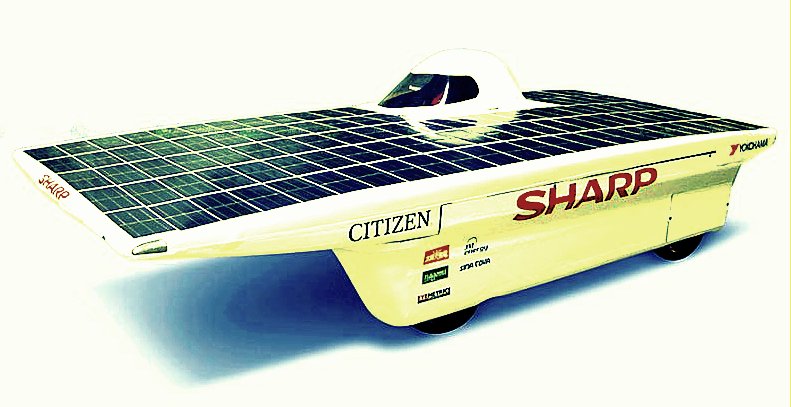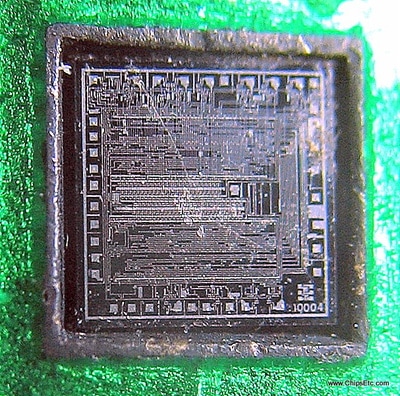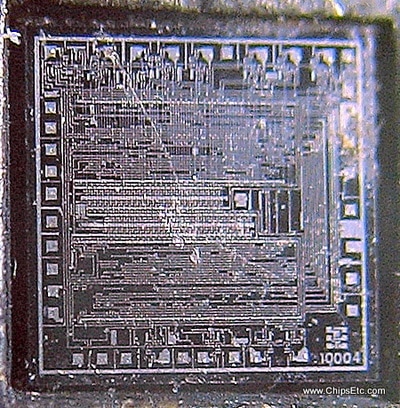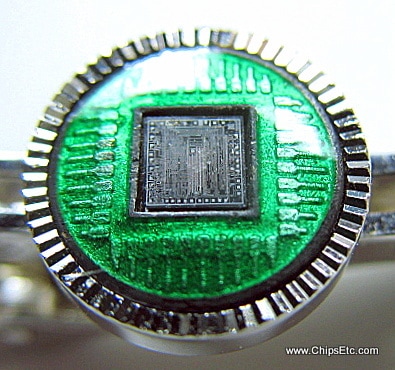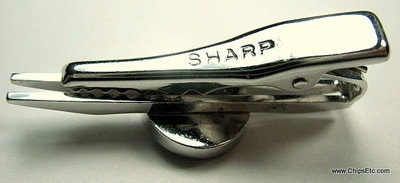|
Company: Sharp Corporation Based: Saika, Japan Founded: 1912 (Sold to Foxconn Technology Goup in 2016) Founder: Tokuji Hayakawa Specialty: Major consumer Electronics Manufacturer. Televisions, microwave ovens, Integrated Circuits, Solar Cells, Mobile Phones, fax machines, calculators & more. Developed the world’s first transistorized calculator, first LCD dsipaly calculator, first commercial camera phone, and the first 8k Television. |
|
Sharp Microelectronics Intergrated Circuit Chip Tie clasp (1970s)
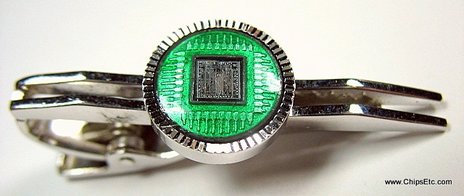
Item #953
This tie clasp from Sharp Microelectronics features one of their Integrated Circuit Chips. The only identifier on the chip is "10004".
Sharp started selling transistorized calculators in 1964. In 1967, Sharp would introduce their first IC-based Electronic destop calculator that used MOS Integrated Circuits made by Mitsubishi.
In 1971 Sharp would introduce the worlds first battery powered handheld electronic calculator, the Sharp QT-8B "micro Compet", which used 4 MOS LSI IC's made by Rockwell.
Sharp had numerous competitors in the growing electronic calculator market including american calculator maker Smith-Corona Marchant, and japanese calculator makers Sony, Casio, Canon, Hitachi, Busicom, and Oki Electric Co.
Each of these early Japanese calculator companies would come out with their own unique calculator designs with Integrated Circuits supplied through individual alliances with key American semiconductor companies. Many of whom would go on to make their own line of calculators, including General Instrument, Texas Instruments, and Hewlett Packard.
North American Rockwell Microelectronics was the key manufacturer of LSI calculator integrated circuits for Sharp's calculators.
The list of Integrated Circuit manufacturers who became suppliers to the early electronic calculator industry included Intel, Texas Instruments, North-American Rockwell Microelectronics, Mostek, Motorola, AMI, Fairchild Semiconductor, RCA, National Semiconductor, Mitsubishi, and Sanyo.
Sharp started selling transistorized calculators in 1964. In 1967, Sharp would introduce their first IC-based Electronic destop calculator that used MOS Integrated Circuits made by Mitsubishi.
In 1971 Sharp would introduce the worlds first battery powered handheld electronic calculator, the Sharp QT-8B "micro Compet", which used 4 MOS LSI IC's made by Rockwell.
Sharp had numerous competitors in the growing electronic calculator market including american calculator maker Smith-Corona Marchant, and japanese calculator makers Sony, Casio, Canon, Hitachi, Busicom, and Oki Electric Co.
Each of these early Japanese calculator companies would come out with their own unique calculator designs with Integrated Circuits supplied through individual alliances with key American semiconductor companies. Many of whom would go on to make their own line of calculators, including General Instrument, Texas Instruments, and Hewlett Packard.
North American Rockwell Microelectronics was the key manufacturer of LSI calculator integrated circuits for Sharp's calculators.
The list of Integrated Circuit manufacturers who became suppliers to the early electronic calculator industry included Intel, Texas Instruments, North-American Rockwell Microelectronics, Mostek, Motorola, AMI, Fairchild Semiconductor, RCA, National Semiconductor, Mitsubishi, and Sanyo.
The Evolution of Calculator Chips used in Sharp Calculators During the 1970's
In the 1970s, Sharp calculators underwent a significant technological evolution, driven by the development and integration of various IC chips. These chips played a crucial role in the functionality and performance of the calculators during this era. Notably, Rockwell MOS-LSI chips, Hitachi HD3685 processor, and compact flat-panel fluorescent display modules were among the key components used in Sharp calculators during the 1970s.
The Sharp QT-8B, introduced in 1970, featured a 4-piece chipset manufactured by Rockwell, signifying the early adoption of integrated circuits in calculators. Similarly, the Sharp Model EL-8118, released in 1976, utilized a single MOS-LSI chip, showcasing the advancement in chip technology during this period. Furthermore, the Sharp CS-363 from 1971 employed six Rockwell MOS-LSI chips, reflecting the rapid progress made in integrated circuit technology during the early years of the 1970s
.
The introduction of the "calculator-on-a-chip" concept was a pivotal development during this time, as it led to the integration of all the necessary calculator functionalities into a single IC chip. This innovation was a significant aspect of the "calculator war" that characterized the competition among various companies in the 1970s.The utilization of these chips in Sharp calculators not only enhanced their computational capabilities but also contributed to the miniaturization and portability of these devices. The integration of advanced chips allowed for the creation of more compact and efficient calculators, marking a transformative period in the history of calculator technology.
The chips used in Sharp calculators during the 1970s, such as Rockwell MOS-LSI chips, Hitachi HD3685 processor, and compact flat-panel fluorescent display modules, played a pivotal role in shaping the technological landscape of calculators during this era. These advancements laid the foundation for the modern calculators we use today, marking a significant milestone in the history of electronic devices.

